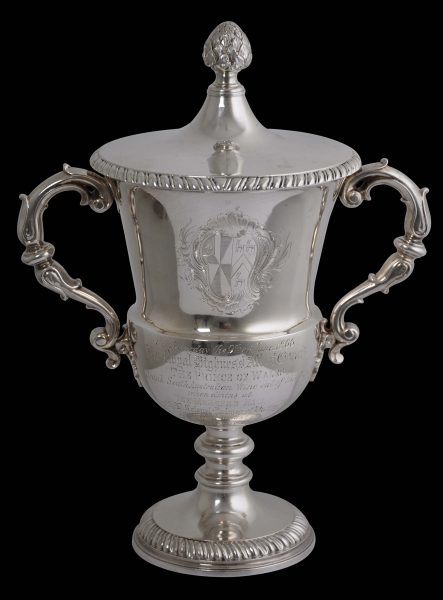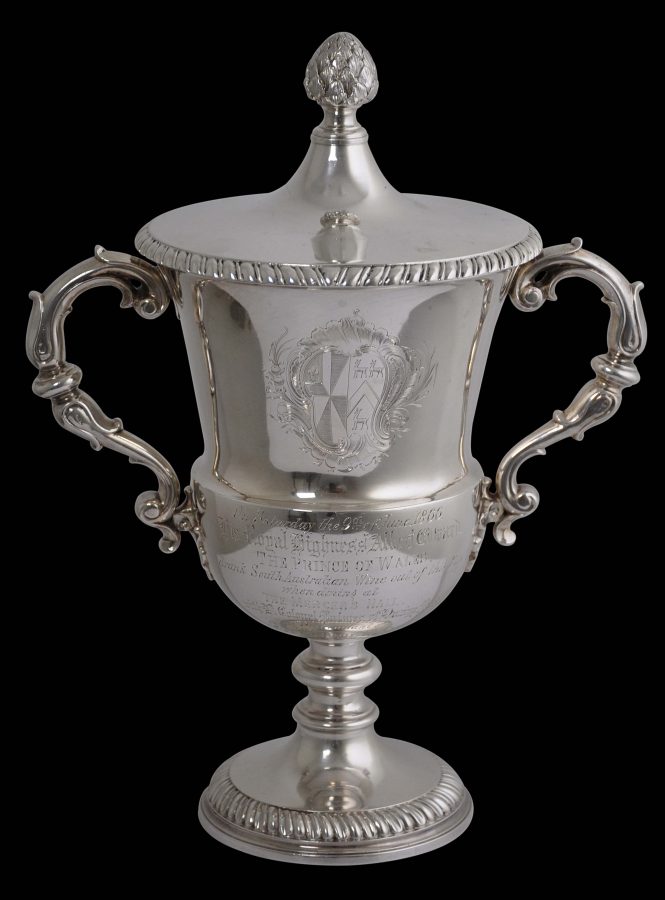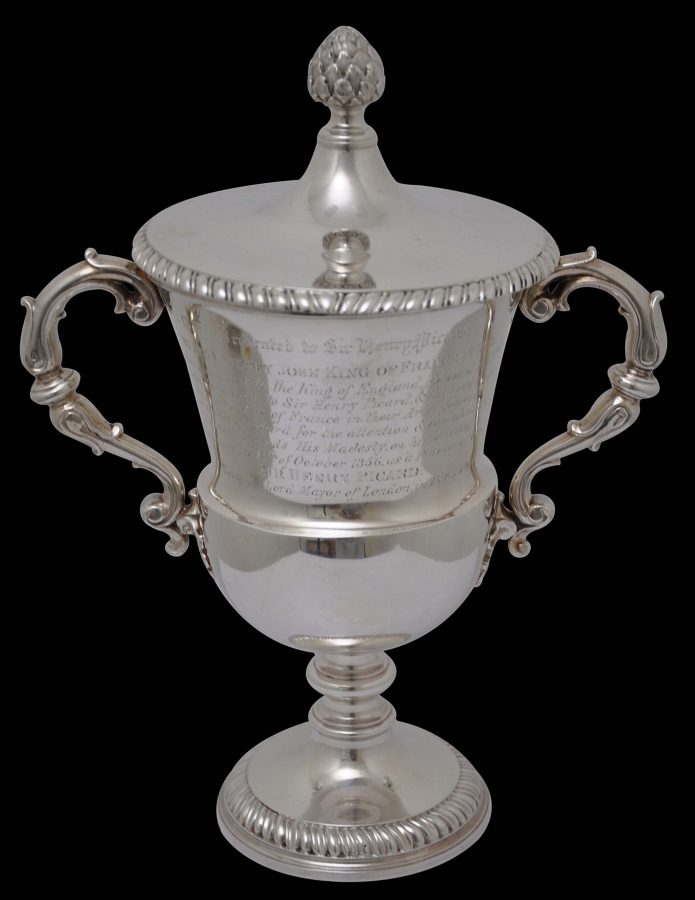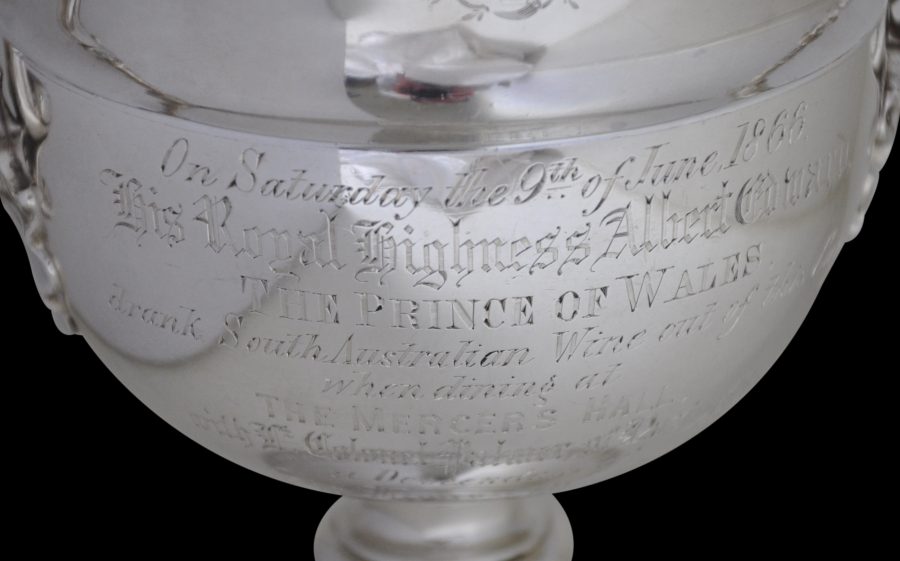Enquiry about object: 2729
Inscribed Silver ‘Loving’ Cup & Cover used by the Prince of Wales to Drink South Australian Wine in 1866
England inscribed in 1866 & with marks for 1741
height: 28.5cm, weight: 1,205g
Provenance
the descendants of Frederick Hamilton-Temple-Blackwood, 1st Marquess of Dufferin and Ava, former Viceroy of India.
This cup, known as a loving cup, with two handles and a cover, is remarkable for its inscription. It provides relatively early (1866) documentary evidence of South Australian wine being exported to and consumed in London. The novelty value of South Australian wine must have been such that it was worthy of mention on the cup. But also that it was considered worth drinking – for it was consumed from this cup by no less than the Prince of Wales, who later would be crowned King Edward VII.
The main inscription reads thus:
‘On Saturday the 9th June 1866, his Royal Highness Albert Edward, the Prince of Wales, drank South Australian wine out of this cup when dining at the Mercer’s Hall with Lt Colonel Palmer of Nazing Park, a descendant of Sir Henry Picard.’
This inscription appears below an engraving of what presumably is the Picard family arms.
The other side of the cup explains who Sir Henry Picard was:
‘Presented to Sir Henry Picard by His Majesty John King of France in 1363 when upon a visit to the King of England Edward the 3rd with permission to Sir Henry Picard and his heirs to bear the fleur de lis of France in their arms for ever as a token of regard for the attention and consideration evinced towards his majesty on his arriving in London on the 13th of October 1356 as a prisoner of war. Sir Henry Picard being the Lord Mayor of London in 1356 & 1357.’
The Prince of Wales was the first member of the Royal Family to be admitted to the Mercers’ Company. He attended the Mercers’ Hall on June 8, 1863, for his admission ceremony, which was followed by a lunch.
Colonel Palmer had significant links to South Australia. (A photograph of him is preserved in the Adelaide City Archives.) The colony of South Australia was founded in 1834 with an act of the British Parliament, the South Australia Colonisation Act 1834. The Act allowed for three or more appointed commissioners, called the Colonisation Commissioners for South Australia, to oversee the sale and leasing of land in South Australia to British subjects. The money raised by the sale and leasing of land was paid into the Emigration Fund which was to be applied to the cost conveying further immigrants from Great Britain and Ireland. The Act was repealed and the Colonisation Commission abolished by the South Australia Act 1842. Colonel George Palmer served as a Colonisation Commissioner – the small town of Palmer just east of the Adelaide Hills was named after him.
Palmer almost certainly was a member of the Mercer’s Company. Many of the guilds or the Companies of the City of London have their origins in medieval times and became fabulously wealthy. They held (and still hold) regular lavish dinners for their members and are well known for their large cellars of extensive wine stocks to be served at these dinners. Palmer’s South Australian connections undoubtedly were the reason that the Company served South Australian wine in 1866, and in this way, it shows how personal connections in the City aided the distribution and acceptance of products such as South Australian wine from the colonies.
The earliest evidence of vine planting in South Australia was in 1836 by a settler named John Barton Hack in North Adelaide. Another settler planted a small vineyard in 1838 which is thought to have produced wine as early as 1841. A case of Hack’s wine was sent to Queen Victoria in 1843, and this is believed to be the first Australian wine to reach the Queen. Vines for what became the Grange vineyard were planted in 1844 by Dr Christopher Rawson Penfold. He planted vine cuttings from southern France that he had brought with him when emigrating to Australia. The wine served to the Prince of Wales from the cup here dates to the early period of South Australian wine production – within 30 years of the first attempts to produce wine in the colony.
The cup itself is of typical form for a loving cup – it has a foot and stem, a wide body and two handles on either side to allow it to be passed from diner to diner around the table at a guild or company function, post dinner, when it was traditional for all those present to take a sip from the same cup before passing it on. The presence of the original cover is important. Often, these are lost. The cover itself is of domed form and is surmounted by a particularly fine pine cone finial. The engraving on the cup is dated 1866, but the cup itself was made in London and assayed in 1741 (both the cup and cover bear London assay marks) so already had significant age when it was used for the event. The cup and cover are free of any dents, splits or repairs. There is little wear from polishing and the inscriptions are crisp and legible. Overall, this is a rare item of historical interest for South Australia, its wine industry, but also for those interested in royalty and the City of London guilds.





